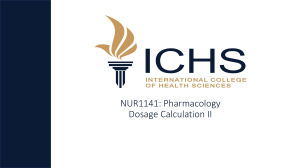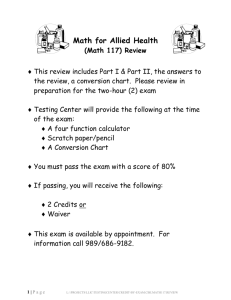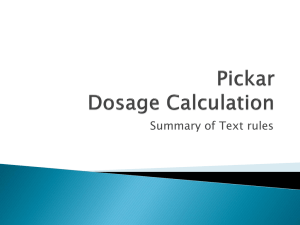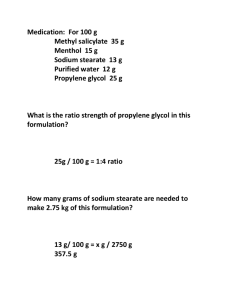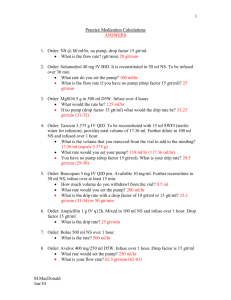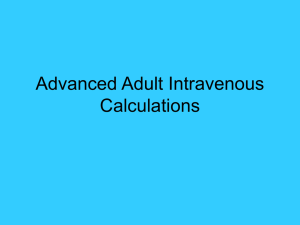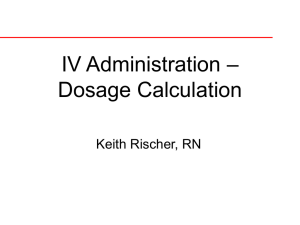Nursing Calculations: Dimensional Analysis & IV Drip Rates
advertisement
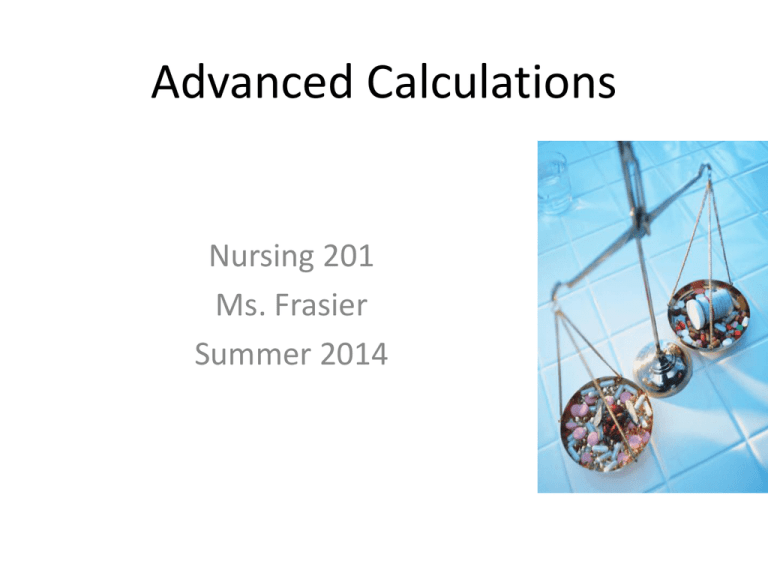
Advanced Calculations Nursing 201 Ms. Frasier Summer 2014 Dimensional Analysis Simple technique with a fancy name Allows manipulation of units Also referred as factor label method or the unit factor method Less errors The advantage of dimensional analysis is only one equation is needed Review ml/hr gtt/min Infusion of IV fluids with an IV pump Solve for mL/h The formula: x mL/h = Total volume in milliliters Total time in hours On the left side of the equation, place what you are solving 𝑚𝑙 for. X = ℎ𝑟 On the right side of the equation, place the available information related to the measurement that was placed on the left side of the equation. 1000ml 8h Answer 125mL/hr Drops per minute (gtt/min) Knowing the drop factor is the first step The drop factor always appears on the IV package Macrodrops are large and deliver 10, 15, 20 gtt/mL Microdrops are small and deliver 60 gtt/mL Drop factor = gtt/mL Example: order: D5W to infuse at 100ml/hr. drop factor 10gtt/mL. at what rate in gtt/min should the IV be regulated? 1. You are calculating for gtt/min, so write gtt/min to the left of the equation, (that is what you are looking for) 2. Extract the information that contains gtt/min from the problem; drop factor is 10gtt/mL. add this factor into the equation. X gtt = 10gtt min mL The next fraction is written so that the denominator matches the previous fraction (what you are looking for). Looking back at problem we are to infuse 100mL in 1 hr. enter the 1hr as 60min since we are looking for gtt/min. 𝑥𝑔𝑡𝑡 𝑚𝑖𝑛 = 10𝑔𝑡𝑡 ×100𝑚𝐿 1𝑚𝐿 × 60𝑚𝑖𝑛 = 1000 60 = 16.6 =17𝑔𝑡𝑡/𝑚𝑖𝑛 Order: An IV medication of 50mL NS in 20 min. drop factor (60gtt/mL). At what rate in gtt/min should the IV be regulated? You are calculating gtt/min, so write gtt/min to the left of the equation, followed by equals sign, label x, since that is what you are looking for: extract the information that contains gtt from the problem. Drop factor 60gtts/mL. numerators match up 𝑥𝑔𝑡𝑡 𝑚𝑖𝑛 ₌ 60𝑔𝑡𝑡 𝑚𝐿 × 50𝑚𝐿 20 = 3000 20 = 150𝑔𝑡𝑡/𝑚𝑖𝑛 Practice Problems Calculate the flow rate in mL/hr using dimensional analysis 1. 1,800 mL of D5W in 24 hr by infusion pump _____________ 2. 2,000 mL D5W in 24 hr by infusion pump _______________ 3. 500 mL RL in 12 hr by infusion pump __________________ 4. 100 mL 0.45% NS in 45 min by infusion pump ___________ 5. 1,500 mL D5LR in 24 hr by infusion pump _______________ 6. 750mL D5W in 16 hr by infusion pump ________________ 7. 30 mL of Ancef in 0.9% NS in 20min by infusion pump _____ Answers = 1800𝑚𝑙 24ℎ𝑟 = 75𝑚𝐿/ℎ𝑟 2. × ℎ𝑟 = 2000𝑚𝑙 24ℎ𝑟 = 83.3 = 83𝑚𝐿/ℎ𝑟 1. × 𝑚𝐿 ℎ𝑟 𝑚𝑙 𝑚𝐿 3. 𝑥 ℎ𝑟 = 𝑚𝐿 4. × ℎ𝑟 = 5. × 𝑚𝐿 ℎ𝑟 = 500𝑚𝐿 12ℎ𝑟 = 41.6 = 42𝑚𝑙/ℎ𝑟 100𝑚𝐿 45𝑚𝑖𝑛 1500𝑚𝐿 24ℎ𝑟 𝑚𝐿 750𝑚𝐿 16ℎ𝑟 𝑚𝑙 30𝑚𝐿 6. × ℎ𝑟 = × 60𝑚𝑖𝑛 1ℎ𝑟 = 400 3 = 133mL/hr = 62.5 = 63mL/hr = 46.8 = 47 𝑚𝐿/ℎ𝑟 7. × ℎ𝑟 = 20𝑚𝑖𝑛 × 60𝑚𝑖𝑛 1ℎ𝑟 = 90 1 = 90𝑚𝐿/ℎ𝑟 Practice Problems Calculate the flow rate in gtt / min using dimensional analysis 1. Administer D5LR at 75mL/hr. the drop factor is 10gtt/mL 2. Administer D5NS at 30mL/hr. the drop factor is a microdrop 3. Administer RL at 125mL/hr. the drop factor is 15gtt/mL 4. Administer 1000 mL D5NS in 6 hrs. the drop factor is 15gtt/mL 5. An IV medication in 60mL of NS is to be given in 45 min. the drop factor is a microdrop 6. 1000 mL of LR is to infuse in 16 hr. the drop factor is 15gtt/mL 7. Infuse 150mL of D5W in 2hr. The drop factor is 20gtt/mL Answers 1. × 𝑔𝑡𝑡 𝑚𝑖𝑛 × 75𝑚𝐿 ℎ𝑟 = 60 𝑚𝐿 × 30𝑚𝐿 ℎ𝑟 3. × 𝑚𝑖𝑛 = 15 𝑚𝐿 × 125𝑚𝑙 1ℎ𝑟 2. × 𝑔𝑡𝑡 𝑚𝑖𝑛 = 10𝑔𝑡𝑡 𝑚𝐿 𝑔𝑡𝑡 𝑔𝑡𝑡 4. × 𝑚𝑖𝑛 = × × × 1ℎ𝑟 60𝑚𝑖𝑛 1ℎ𝑟 60𝑚𝑖𝑛 = = 60 2 750 60 = = 12.5 = 13𝑔𝑡𝑡 𝑚𝑖𝑛 30𝑔𝑡𝑡 𝑚𝑖𝑛 1ℎ𝑟 1875 31𝑔𝑡𝑡 = = 31.25 = 60 𝑚𝑖𝑛 60𝑚𝑖𝑛 15𝑔𝑡𝑡 1000𝑚𝐿 1ℎ𝑟 × × = step 1: calculate mL/hr 𝑚𝐿 6ℎ𝑟 60𝑚𝑖𝑛 15𝑔𝑡𝑡 167𝑚𝐿 1ℎ𝑟 2505 × × = = 41.7 = 42𝑔𝑡𝑡/𝑚𝑖𝑛 𝑚𝐿 1ℎ𝑟 60𝑚𝑖𝑛 60 𝑔𝑡𝑡 60𝑔𝑡𝑡 𝑚𝐿 𝑔𝑡𝑡 15𝑔𝑡𝑡 1000𝑚𝐿 1ℎ𝑟 × × = 𝑠𝑡𝑒𝑝 1: 𝑐𝑎𝑙𝑐𝑢𝑙𝑎𝑡𝑒 𝑚𝐿/ℎ𝑟 𝑚𝐿 16ℎ𝑟 60𝑚𝑖𝑛 15𝑔𝑡𝑡 63𝑚𝐿 1ℎ𝑟 63 × × = = 15.75 = 16𝑔𝑡𝑡/𝑚𝑖𝑛 𝑚𝑙 1ℎ𝑟 60𝑚𝑖𝑛 4 5. × 𝑚𝑖𝑛 = 6. × 𝑚𝑖𝑛 = × 60𝑚𝐿 45𝑚𝑖𝑛 = 240 3 = 80𝑔𝑡𝑡 𝑚𝑖𝑛 Critical Care Calculations Critically ill clients receive medications that are potent and require close monitoring Titrated medications are added to a specific volume of fluid and rate adjusted to desired effect; when a solution is titrated, the lowest dosage of the med is set first and ↑ or ↓ as necessary The drugs that are titrated are potent antiarrhythmics, vasopressor, and vasodilator medications Infusion pumps are used for titration Critical Care Calculations • Volume • mL / hr • Dosage • • • • • • • • mg / min mg / hr mcg / min mcg / hr mcg / kg / min mg / kg / min mcg / kg / hr mg / kg / hr • mg / min • mg / hr A client is receiving Pronestyl 60mL/hr. the solution available is pronestyl 2g in 500mL D5W . Calculate the mg/hr and the mg/min the client will receive. 𝑚𝑔 x ℎ𝑟 × = 𝑚𝑔 𝑚𝑖𝑛 1000𝑚𝑔 1𝑔 = × 1000𝑚𝑔 1𝑔 2𝑔 500𝑚𝐿 × × 2𝑔 500𝑚𝐿 60𝑚𝐿 1ℎ𝑟 × = 60𝑚𝑙 60𝑚𝑖𝑛 240𝑚𝑔 1ℎ𝑟 = = 240𝑚𝑔/ℎ𝑟 240𝑚𝑔 60 =4 mg/min mcg / min mcg / hr Order: a patient with heart failure has nitroglycerin infusing at 3mL/h. the nitroglycerin concentration is 100mg in 500 mL of D5W. At what rate, in micrograms per minute, is the nitroglycerin infusing? × 𝑚𝑐𝑔 𝑚𝑖𝑛 × 𝑚𝑐𝑔 ℎ𝑟 = 1000𝑚𝑐𝑔 1𝑚𝑔 × 100𝑚𝑔 500𝑚𝐿 = 1000𝑚𝑐𝑔 1𝑚𝑔 × 100𝑚𝑔 500𝑚𝐿 × 3𝑚𝐿 1ℎ𝑟 × × 3𝑚𝐿 ℎ𝑟 1ℎ𝑟 60𝑚𝑖𝑛 = = 600𝑚𝑐𝑔 ℎ𝑟 600 60 = 10𝑚𝑐𝑔 𝑚𝑖𝑛 • mcg/kg/min • mcg/kg/hr Order: 400 mg of dopamine is added to 250ml. Of 0.9% NS. The order is to begin the infusion at 2mcg/kg/min. the patient’s weight is 150lb. The nurse needs to calculate the rate, in milliliters per hours, at which to set the IV pump. 1. Convert client’s weight to kilograms: 150lb ÷2.2 = 68.18𝑘𝑔 = 68.2𝑘𝑔 2. Now that you have the client’s weight in kg, determine the dosage per min. 68.2kg x 2mcg/kg/min = 136.4mcg/min 𝑚𝑙 x ℎ𝑟 = 250𝑚𝑙 400𝑚𝑔 × 1𝑚𝑔 1000𝑚𝑐𝑔 × 136.4𝑚𝑐𝑔 1𝑚𝑖𝑛 × 60𝑚𝑖𝑛 1ℎ𝑟 = 40,920 = 5 𝑚𝑙/ℎ𝑟 8000 Practice Problems 1. A client weighing 50kg is to receive a Dobutrex solution of 250mg in 500ml D5W ordered to titrate between 2.5 and 5 mcg/kg/min. a. Determine the flow rate setting for a volumetric pump. b. If the IV flow rate is being maintained at 25mL/hr after several titrations, what is the dosage infusing per minute? 2. Order: Epinephrine at 30mL/hr. The solution available is 2mg of epinephrine in 250mL D5W. Calculate the following: a. mg/hr b. mcg/hr c. mcg/min 3. Aminophylline 0.25g is added to 500mL D5W to infuse at 20mL/hr. Calculate the following: a. mg/hr 4. Order: 3mcg/kg/min of Nipride: Available: 50mg of Nipride in 250mL D5W . Client’s weight is 60 kg. a. Calculate the flow rate in mL/hr that will deliver this dosage. 5. A nitroglycerin drip is infusing at 3mL/hr. The solution available is 50mg of nitroglycerin in 250mL D5W. Calculate the following: a. mcg/hr b. mcg/min Heparin IV • HIGH ALERT MEDICATION • Heparin is a potent anticoagulant that prevents clot formation and blood coagulation • Expressed in units (no “U” abbreviation) • The therapeutic range for heparin is determined individually by monitoring the client’s blood clotting value (APTT – activated partial thromboplastin time) • Heparin is considered to be more therapeutic when based on weight in kg. • May be given SQ or IV. Never IM. • Should always be on a pump…will be ordered either ml/hr or units/hr • Remember heparin comes in many different strengths. Make sure you have the correct one. Examples • mL/hr – units/hr Order: 15 units/hour. On hand you have 40units in 250ml of NS. How many ml/hr will you administer? 𝑚𝑙 ℎ𝑟 = 250𝑚𝑙 40𝑢𝑛𝑖𝑡𝑠 × 15𝑢𝑛𝑖𝑡𝑠 ℎ𝑟 = 3750 40 = 94 ml/hr Order: D5W 1000ml containing 20,000 units of heparin to infuse at 30mL/hr. calculate the dosage of heparin the client is to receive per hour. 𝑢𝑛𝑖𝑡𝑠 ℎ𝑟 = 20,000𝑢𝑛𝑖𝑡𝑠 1000𝑚𝐿 × 30𝑚𝐿 ℎ𝑟 = 600000 1000 = 600 units per hour Calculating heparin dosages based on weight A client weighs 165 lb. Order: heparin 25,000 units in 1000ml 0.9% sodium chloride. Bolus with heparin at 80units/kg, then initiate drip at 18units/kg/hr. calculate the initial bolus dosage, then calculate the infusion rate at ml/hr. 𝑥 𝑢𝑛𝑖𝑡𝑠 𝑚𝑙 ℎ𝑟 Or = = 80𝑢𝑛𝑖𝑡𝑠 𝑘𝑔 1000𝑚𝐿 25000𝑢𝑛𝑖𝑡𝑠 𝑚𝑙 ℎ𝑟 = × × 𝑜𝑛𝑒 𝑘𝑔 2.2𝑙𝑏 1350𝑢𝑛𝑖𝑡𝑠 ℎ𝑟 1000𝑚𝑙 25000𝑢𝑛𝑖𝑡𝑠 × = 18𝑢𝑛𝑖𝑡𝑠 𝑘𝑔 x 165𝑙𝑏 1 1350 25 × = 13200 = 6000 𝑢𝑛𝑖𝑡𝑠 𝐼𝑉 bolus 2.2 = 54ml/hr 75𝑘𝑔 ℎ𝑟 = 1350 𝑚𝑙 25𝑢𝑛𝑖𝑡𝑠 = 54𝑚𝐿/ℎ𝑟 A client weighs 176 lb. Heparin infusion 20,000 units in 1000mL 0.9% sodium chloride. Order: bolus with heparin sodium at 80units/kg, then initiate drip at 18units/kg/hr. Calculate the following: a. ___________ bolus dosage b. ___________ infusion rate (initial) c. ___________ mL/hr Answers: 6400 units, 1440units/hr, 72mL/hr 46. pg.519 Order: Heparin drip at 18units/kg. Available: 25,000units of heparin in 1,000mL of D5W. The client weighs 80 kg. At what rate will you set the infusion pump? First determine units/kg the client should receive. 18x80 = 1440units then mL/hr Answer: 58 mL/hr 47. Pg 519 A client weighs 200 lb. Order: Administer a bolus of heparin sodium IV at 80units/kg. how many units will you administer: 𝑢𝑛𝑖𝑡𝑠 = 80𝑢𝑛𝑖𝑡𝑠 𝑥 𝑘𝑔 × 1𝑘𝑔 2.2 𝑙𝑏 × 200𝑙𝑏 1 = 7,272 𝑢𝑛𝑖𝑡𝑠 48. pg. 520 A client weight 210 lb. Order: Heparin IV infusion: heparin sodium 25,000 units in 1,000 mL of 0.9% NS. Order is give a bolus with heparin sodium 80units/kg, then initiate drip at 18units/kg/hr. Calculate the following: a. Heparin bolus dosage ____________________ b. Infusion rate for the IV (initial) _____________ c. At what rate will you set the infusion pump? ___________ • Practice! Practice! Practice! • Review Heparin Weight Based Protocol
